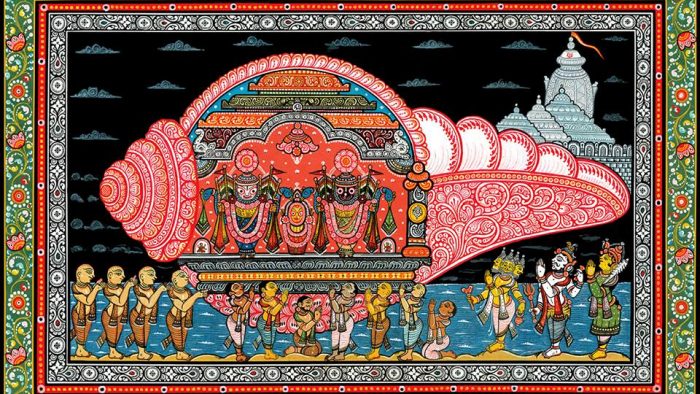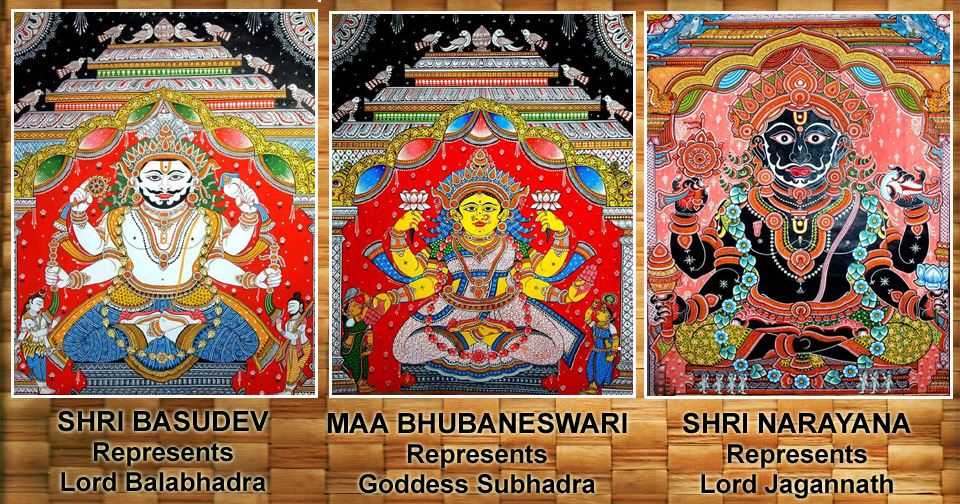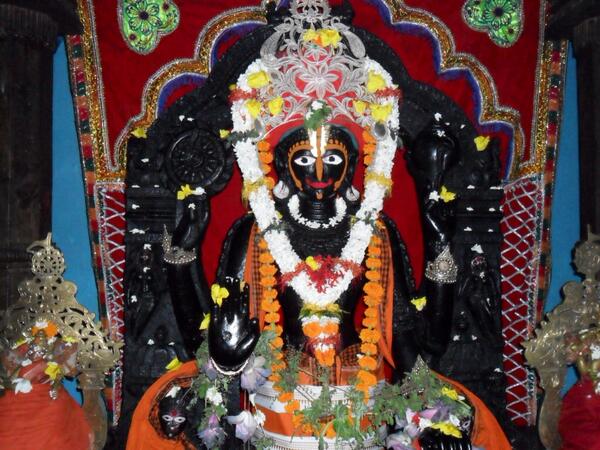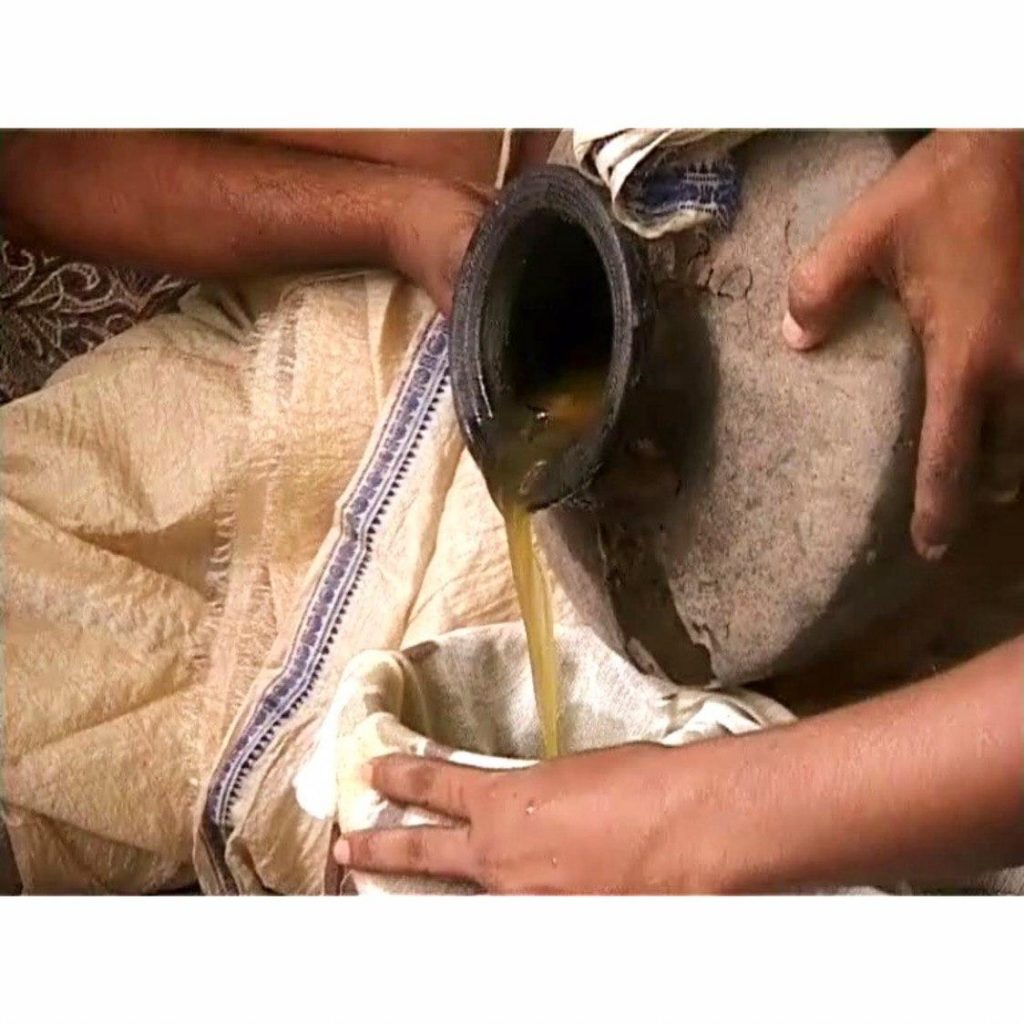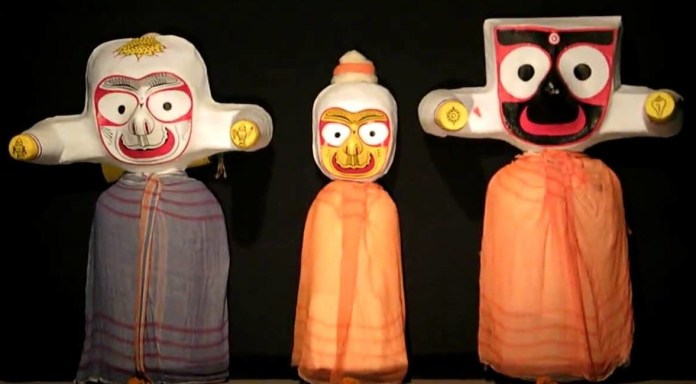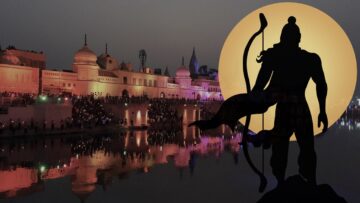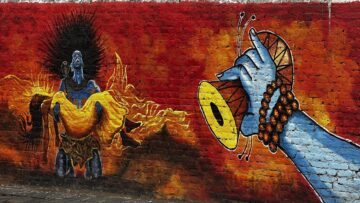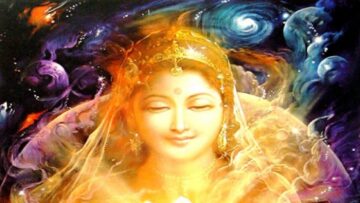The Ratha Yatra of Shri Jagannath is initiated with the – Deva Snana Yatra and ends with the Niladri Bije Yatra. From initiation to the conclusion the entire period is divided into Six Yatras. Snana Yatra is followed by Anabasara Yatra which is the second ritualistic Yatra of the Trinity. The period between the Snana Yatra and Ratha Yatra is referred to as the Anabasara Yatra.
Shri Jagannath, the Living Deity of the Kali Yuga is said to be engrossed in ‘Manaviya Leela’- The Humanly activities. Jyeshtha Purnima marks the birth of Lord Jagannath and also the religious bath ritual prevalently known as the Deva Snana Purnima. Too much of bathing in the humid weather of Puri causes the Deities to catch a bad cold leading to fever and this further leads to the isolation of the Gods from His devotees for a fortnight. This period of sickness is the Anasara or Anabasara period of the Gods. The word ‘Anabasara’ is formed by the combination of two words- ‘Na’and ‘Abasara’. The Niti-Kanti or procedures done inside the Anabasara Gruha, also known as the ‘Nirodhana Gruha Krutya’ is not made public and is known as ‘Gupta Shabara Seva’ done by the Daitapati sevayats .
Dasaavatara Patti
During the sick period of the Triad, the idols are kept in seclusion, in the custody of the Daitapati sevaks. The idols are kept cordoned behind a temporary rattan fence, within the temple premises. Three barricaded enclosures are erected for the three Deities. The Patti meaning the traditional Pattachitra painting, known as the ‘Dasaavatara Patti’- The painting of ten incarnations is offered ritualistic offerings by the Daitapati and the Pati Mohapatra sevaks on the Abasara Pindi.
The Dasaavatara Patti painting has images of seven Deities and totals to ten along with the idols of Sri Balabhadra, Devi Subhadra, and Sri Jagannath.
“ नरसिंघम राम कृष्णम चः
श्री भू भद्रः स्वरुपिणी
कृष्ण नारायणम तनी
सप्त वरण बिगरहः। “
“Narasiṃghama Rāma Kṛṣṇama caḥ
Srī Bhū bhadraḥ Svarupiṇī
Kṛṣṇa Nārāyaṇama Tanī
Sapta Varaṇa Bigarahaḥ”
Bamadeva Samhita
The above lines illustrate the Dasaavatra Patti. The sick enclosure of Lord Balabhadra has the Patti of three Deities -Nursingha, Rama, and Krishna. Devi Subhadra’s enclosure has the Patti of two Deities Devi Lakshmi and Devi Saraswati; the enclosure of Shri Jagannath has the Patti of two Deities Krishna and Narayana. All together along with Shri Balabhadra, Devi Subhadra and Shri Jagannath in total adds up to ten Deities. Together they form the Dasaavatar Patti.
The rituals during the quarantine period are kept off public viewing. The public audience of the Trinity is barred until Ratha Yatra
Patti Diyan
During the fortnight of sickness, the Ratnabedi in the sanctum sanctorum of the Srimandira remains vacant. The Gods remain in the sick quarters. The devotees are not allowed to see the Gods during Anabasara.
“स्वरुपम्बा आरुपम्बा न पस्यत् पन्चहासानि।“
“Svarrupambā ārupambā na pasyat pancahāsāni”
The above lines convey that the Divine should not be seen as a Swaroop-own self or Aroop-Distorted self during these fifteen-day quarantine periods.
In the absence of the Divine Triad, the ‘Patti Diyan’, the vibrant pattachitra paintings of the three Gods in a beautiful distinct form are offered worship inside the main temple. Each Patta painting is around 5.5 feet long and 4 feet wide and depicts Shri Balabhadra as Ananta Basudev, Devi Subhadra is depicted as Goddess Bhubaneswari and Shri Jagannath is seen as Ananta Narayana. While the idols of Shri Balabhadra, Devi Subhadra, and Shri Jagannath, are incomplete and unstructured, in the Patti Diyan’s they manifest themselves in human-like structured bodies, with suitable attire and ornamentation. These paintings are worshipped inside the temple from the Anasara period up to the day on which the Trinity returns from the annual sojourn that they undertake to the Gundicha temple during the annual Ratha Yatra.
Special Chitrakara Sevaks are assigned the task of painting the Patti Dian. The patta or silken cloth is the canvas used for these paintings. Special rituals are followed for the creation of these paintings. The Chitrakars initiate the paintings on Jyestha Amavasya and complete the paintings by Jyestha Purnima, the day celebrated as the Snana Yatra of the Triad. The day after Snana Purnima these colorful traditional paintings are installed in the Srimandira as the representative replacement of the ailing Gods. These paintings are filled with organic handmade colors.
Alarnath Temple
During the Anabasara period, the regular idols of Shri Balabhadra, Devi Subhadra, and Shri Jagannath are kept in isolation for fifteen days. During these fifteen days, Shri Jagannath manifests himself as Shri Alarnath in Chatur Bhuja Vishnu avatar along with Lakshmi and Saraswati. He gives darshan to His devotees at the Alarnath or the Alwarnath temple at the distance of twenty-three Kilometers from Puri at a place called Brahmagiri. The Idol in the Alarnath Temple is made of black stone and has all the signature traits of Lord Vishnu.
As per legend, it is believed that Lord Jagannath was kept in the custody of Biswabasu the tribal king, as Nilamadhaba in the Nilanchal hills before reincarnating himself as the wooden idol of Shri Jagannath in Puri. It is believed that the idol enshrined inside the Alarnatha temple at Brahmagiri is that of Shri Nilamadhaba, who gives an audience to His devotees during the Anabasara isolation of the Triad.
As per another legend, it is conveyed that in Sata Yug, Lord Brahma worshipped Lord Vishnu atop of a hill. One day Bhagwan Vishnu appeared and asked Brahma to create a four-armed idol of Him at the same place. He specified that the idol is carved out of black stone and should be of holding the Shankha, Chakra, Gada, and Padma. He further instructed that an idol of the Divine bird Garuda should also be installed inside the temple. Finally, Lord Vishnu named the place,‘Brahmagiri’- The Giri (hill) where Brahma had worshipped Lord Vishnu. Brahma, taking instructions from Lord Vishnu acted accordingly and created Lord Alarnatha, another incarnation of Lord Vishnu.
Swakriya-Rasa
The fortnight of sickness is also the leisure period of Shri Jagannath. It is believed that it is during the Anabasara of Shri Jagannath, that God is engaged in the Madhura Rasa. These fifteen days of seclusion is the intimate time He spends with his wife. He is engaged in dedicating time, presence, and showering His love on His beloved consort, Goddess Lakshmi in Swakriya-Rasa. This aspect of Swakriya-Rasa speaks about the conjugal relationship of Shri Jagannath with his wife as followed by Shri Krishna with his married queens in Dwarka. Post the fifteen-day privacy phase with Goddess Lakshmi, Shri Jagannath will be engaged in the Parakiya- Rasa.
Treatment and Maintenance
The idols of the Trinity– Shri Balabhadra, Devi Subhadra, and Shri Jagannath along with Shri Sudarshana are made of the Divine timber- The Daru Brahma. The sickness time of the Gods is a phase when the Gods are treated for their sickness. In this period the wooden idols are also maintained and given an annual freshening touch-up before they give the grandest public audience, during the Ratha Yatra. The treatment and maintenance happen simultaneously in the Gupta Sabara Seva.
The Royal Physician of the Triad takes care of the medicinal requirements. Under his supervision, the Gods are treated to several Ayurvedic concoctions. Ayurvedic medicines made by combining ten herbal ingredients that include Belacheli, Gambahri, Pateli, Fanafana, Aagabathu, Krusnaparni, Shalaparni, Ankranty, Pateli, and Labingkoli are hand pounded, crushed, mixed as per prescribed proportions and thereafter administered to the Deities.
On Panchami– the fifth-day post the Snana Yatra the ‘Phuluri Taila Niti’ – An aromatic oil made by the Bada Odia Muttha is applied to the Deities. Phuluri oil is made with hand-pressed sesame oil which is infused with flowers such as Ketaki, Malli, Bakula, Champa, Kia, Khas Roots, Sesame Oil, Sandalwood Powder, Camphor, Rice Grains, and other ingredients. On Hera Panchami when the Gods are at the Shri Gundicha temple, the concoction is put in earthen pots and preserved under the earth for a year in the Bada Odia Muttha premises. On the fourth day of Anabasara, the pots are dug out of the earth, strained and then made ready to be transported to the Anasar Gruha, to be applied on the idols of the sick Gods by the Daitapati Sevayatas. The application of this oil protects the Divine timber from insects.
The oil massage is followed by the application of an organic sticky gum, naturally extracted from wood apples (Bilva) and Benzoin Resin (Jhuna) in the Ourasa Lagi Niti. This process continues from Sashti to Navami. On the tenth day, the Deities are said to have gained balance and feel better. They are made to sit upright in the Chaka Bije Niti. On ‘Ekadashi’- The eleventh day, the application of ‘Khadee’ or limestone paste is done. On the Khadilagi Ekadashi day, ‘Dasamula Modaka’- Herbal medicinal globules cooked in jaggery, milk solids, and ghee are served to the Trinity.
On Dwadashi– The twelfth day, the Daitapati Sevaks inform the Gajapati Maharaj regarding the improvement in the health of the Deities in the Raja Prasad Bije Niti. The King is given an account of the health status of the Gods.
Trayodashi- Day Thirteen, silken strings that have been hand braided by the Patuari Bisoyee Sevakas are coiled on the idols of the Deities by the Daitapatis in the Ghanalagi Niti. This process takes almost half a day.
The Ghanalagi follows the ‘Banakalagi Niti’. The face and the final touchup makeup of the Deities happen in this ritual. The idols are painted afresh in vibrant colors by the Datta Mahapatra Sevayats.
Throughout the entire fifteen-day episode of Anasara, the Daitas repaint the images in a phased manner that is divided into seven short periods, each of two days duration, and a short period of one day set apart to give finishing touches.
Netroutsava and Nabajouvana Darshana
Post the coloring of the idols in the Banakalagi Niti, the ‘Netroutsava’ – The festival of the eyes is done in the morning of ‘Ubha Amavasya’, a day before the Ratha yatra. The Eyes of the Gods that were repainted are still considered to be closed. In the ‘Netronmilanam Niti’- The ritualistic opening of the eyes is conducted. The ritual includes the touching of the right eye of the Deities’ with a Tulasi (Holy Basil) wand dipped in honey. Thereafter the left eye of the Deities’ is touched with tulsi wand dipped in ghee. Thereafter kohl is applied on the edge of the lower eyelids of both eyes of the Deities’ amidst the chanting of Vedic mantras. After the Netronmilanam Niti, the Triad is back to their healthy forms and with open eyes are ready to give an audience to the devotees. This ritual of restoring the vision of the Triad is known as Netra Utsava.
The Deities are rejuvenated. Feeling fresh and revived they are ready to undertake the Shri Gundicha Ratha Yatra. The evening before the RathaYatra day the Gods appear before their devotees in the ‘NabaJoubana Vesha’ – The New Youthful form. Filled with agility and excitement after the lull of sickness the Deities are in completely geared up for the chariot ride scheduled on the very next day.
This period also marks the last phase of the chariot construction. The three Chariots are painted, decorated, and ready for the annual stay at Shri Gundicha. The Chariots leave the ‘Ratha Khala’- Chariot Construction enclosure and remain parked in front of the Singhadwara, amidst religious singing and dancing. The chariots are now ready for the annual Ghosha Yatra, to be undertaken the next day by the Divine Trinity.
“सर्वरहस्यन्ग्-पुरुशोत्तमस्य,
देवो-न-जनति-कुतह्-मनुश्य॥”
“Sarvṛahasyang-puruśottamasya,
devo-na-janati-kutah-manuśya“
He is the all mystifying Purushottama, whose secrets are unknown to the Gods themselves. We are but mere humans.
Shri Jagannath is the Human-like Divine. He undertakes lake tours, He enjoys a great bath, He falls sick, He gets treated and recovers from the ailment and He enjoys an annual holiday. He is all-pervading. He is absent from the Srimandira but presents at Brahmagiri as Shri Allarnath Narayana. He is infinite. He is unsolved. He is diverse and ever-diversifying for bonding with his devotees.
Let Jagannath Swami be the purpose of my vision.
Disclaimer: The opinions expressed in this article belong to the author. Indic Today is neither responsible nor liable for the accuracy, completeness, suitability, or validity of any information in the article.

